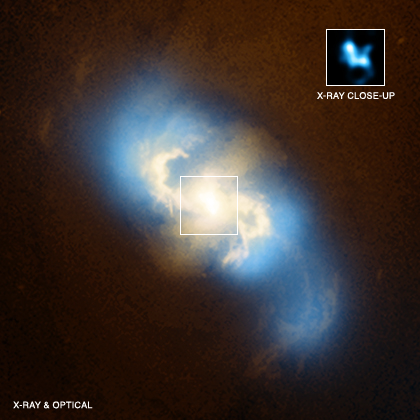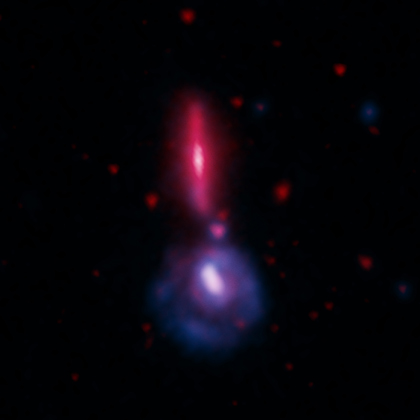Supernova hunters discover a rare beast
Updated: 2011-08-31 11:42:20
 The work of the Galaxy Zoo : Supernova hunters recently paid off with the publication of a paper about a rather unusual supernova. Lead author, Kate Maguire – an astronomer at the University of Oxford working on supernovae and in particular exploding stars that can be used to measure the expansion of the Universe – [...]
The work of the Galaxy Zoo : Supernova hunters recently paid off with the publication of a paper about a rather unusual supernova. Lead author, Kate Maguire – an astronomer at the University of Oxford working on supernovae and in particular exploding stars that can be used to measure the expansion of the Universe – [...]
 CURRENT ISSUE THE MAGAZINE Current Issue Next Issue Back Issues Preview the Magazine Special Issues E-mail Newsletter About the Magazine Subscribe , Renew or Give a Gift Subscriber Benefits Trips Tours Advertise Advertiser Links Sweepstakes Press Room Contact Us COLUMNISTS Bob Berman Glenn Chaple Tony Hallas David H . Levy Stephen James O'Meara NEWS OBSERVING Astronomy News Liz and Bill's Cosmic Adventures StarDome Plus Intro to the Sky Astronomy for Kids Urban Skies Astronomy Myths The Sky this Week The Sky this Month Star Atlas Ask Astro Astro Imaging Constellation Observing Glossary EQUIPMENT Products Reviews How To MULTIMEDIA Picture of the Day Reader Photo Gallery Videos Podcasts Wallpaper COMMUNITY Why Join Local Group Blog Dave's Universe Astronomy Events Astronomy Groups Forums
CURRENT ISSUE THE MAGAZINE Current Issue Next Issue Back Issues Preview the Magazine Special Issues E-mail Newsletter About the Magazine Subscribe , Renew or Give a Gift Subscriber Benefits Trips Tours Advertise Advertiser Links Sweepstakes Press Room Contact Us COLUMNISTS Bob Berman Glenn Chaple Tony Hallas David H . Levy Stephen James O'Meara NEWS OBSERVING Astronomy News Liz and Bill's Cosmic Adventures StarDome Plus Intro to the Sky Astronomy for Kids Urban Skies Astronomy Myths The Sky this Week The Sky this Month Star Atlas Ask Astro Astro Imaging Constellation Observing Glossary EQUIPMENT Products Reviews How To MULTIMEDIA Picture of the Day Reader Photo Gallery Videos Podcasts Wallpaper COMMUNITY Why Join Local Group Blog Dave's Universe Astronomy Events Astronomy Groups Forums A spiral galaxy with two supermassive black holes located about 160 milion light years from Earth.
A spiral galaxy with two supermassive black holes located about 160 milion light years from Earth. CURRENT ISSUE THE MAGAZINE Current Issue Next Issue Back Issues Preview the Magazine Special Issues E-mail Newsletter About the Magazine Subscribe , Renew or Give a Gift Subscriber Benefits Trips Tours Advertise Advertiser Links Sweepstakes Press Room Contact Us COLUMNISTS Bob Berman Glenn Chaple Tony Hallas David H . Levy Stephen James O'Meara NEWS OBSERVING Astronomy News Liz and Bill's Cosmic Adventures StarDome Plus Intro to the Sky Astronomy for Kids Urban Skies Astronomy Myths The Sky this Week The Sky this Month Star Atlas Ask Astro Astro Imaging Constellation Observing Glossary EQUIPMENT Products Reviews How To MULTIMEDIA Picture of the Day Reader Photo Gallery Videos Podcasts Wallpaper COMMUNITY Why Join Local Group Blog Dave's Universe Astronomy Events Astronomy Groups Forums
CURRENT ISSUE THE MAGAZINE Current Issue Next Issue Back Issues Preview the Magazine Special Issues E-mail Newsletter About the Magazine Subscribe , Renew or Give a Gift Subscriber Benefits Trips Tours Advertise Advertiser Links Sweepstakes Press Room Contact Us COLUMNISTS Bob Berman Glenn Chaple Tony Hallas David H . Levy Stephen James O'Meara NEWS OBSERVING Astronomy News Liz and Bill's Cosmic Adventures StarDome Plus Intro to the Sky Astronomy for Kids Urban Skies Astronomy Myths The Sky this Week The Sky this Month Star Atlas Ask Astro Astro Imaging Constellation Observing Glossary EQUIPMENT Products Reviews How To MULTIMEDIA Picture of the Day Reader Photo Gallery Videos Podcasts Wallpaper COMMUNITY Why Join Local Group Blog Dave's Universe Astronomy Events Astronomy Groups Forums Light sources are the ultimate app for particle physics. Researchers around the world use the powerful X-ray beams that light sources create for materials science, protein structure analysis, historical research, pharmaceutical research and drug development and the list keeps going. Argonne National Laboratory published the following story on August 25, 2011 about contributions that the Advanced Photon Source made to developing a new drug to treat skin cancer. For more examples about the applications of particle physics, visit Accelerators for America's Future.
Light sources are the ultimate app for particle physics. Researchers around the world use the powerful X-ray beams that light sources create for materials science, protein structure analysis, historical research, pharmaceutical research and drug development and the list keeps going. Argonne National Laboratory published the following story on August 25, 2011 about contributions that the Advanced Photon Source made to developing a new drug to treat skin cancer. For more examples about the applications of particle physics, visit Accelerators for America's Future.  CURRENT ISSUE THE MAGAZINE Current Issue Next Issue Back Issues Preview the Magazine Special Issues E-mail Newsletter About the Magazine Subscribe , Renew or Give a Gift Subscriber Benefits Trips Tours Advertise Advertiser Links Sweepstakes Press Room Contact Us COLUMNISTS Bob Berman Glenn Chaple Tony Hallas David H . Levy Stephen James O'Meara NEWS OBSERVING Astronomy News Liz and Bill's Cosmic Adventures StarDome Plus Intro to the Sky Astronomy for Kids Urban Skies Astronomy Myths The Sky this Week The Sky this Month Star Atlas Ask Astro Astro Imaging Constellation Observing Glossary EQUIPMENT Products Reviews How To MULTIMEDIA Picture of the Day Reader Photo Gallery Videos Podcasts Wallpaper COMMUNITY Why Join Local Group Blog Dave's Universe Astronomy Events Astronomy Groups Forums
CURRENT ISSUE THE MAGAZINE Current Issue Next Issue Back Issues Preview the Magazine Special Issues E-mail Newsletter About the Magazine Subscribe , Renew or Give a Gift Subscriber Benefits Trips Tours Advertise Advertiser Links Sweepstakes Press Room Contact Us COLUMNISTS Bob Berman Glenn Chaple Tony Hallas David H . Levy Stephen James O'Meara NEWS OBSERVING Astronomy News Liz and Bill's Cosmic Adventures StarDome Plus Intro to the Sky Astronomy for Kids Urban Skies Astronomy Myths The Sky this Week The Sky this Month Star Atlas Ask Astro Astro Imaging Constellation Observing Glossary EQUIPMENT Products Reviews How To MULTIMEDIA Picture of the Day Reader Photo Gallery Videos Podcasts Wallpaper COMMUNITY Why Join Local Group Blog Dave's Universe Astronomy Events Astronomy Groups Forums The physics community got a jolt last year when results showed for the first time that neutrinos and their antimatter counterparts, antineutrinos, might be the odd man out in the particle world and have different masses. This idea was something that went against most commonly accepted theories of how the subatomic world works.
The physics community got a jolt last year when results showed for the first time that neutrinos and their antimatter counterparts, antineutrinos, might be the odd man out in the particle world and have different masses. This idea was something that went against most commonly accepted theories of how the subatomic world works. Scientists on an experiment at CERN announced today that there is more to cloud formation than previously thought. Their study, published in the journal Nature, looked at the effects on cloud formation of vapors and cosmic rays in the atmosphere. The results could help improve the accuracy of climate models.
Scientists on an experiment at CERN announced today that there is more to cloud formation than previously thought. Their study, published in the journal Nature, looked at the effects on cloud formation of vapors and cosmic rays in the atmosphere. The results could help improve the accuracy of climate models. As homage to tape and physics, MIT postdoctoral associate Teppei Katori, who works at Fermilab, created the art piece Selex. Named for a fixed-target charmed baryon experiment that ran in Fermilab’s Tevatron from 1996-97, Selex is part of the exhibit Tape: A Celebration currently showing at the Chicago Art Department in the city’s Pilsen neighborhood.
As homage to tape and physics, MIT postdoctoral associate Teppei Katori, who works at Fermilab, created the art piece Selex. Named for a fixed-target charmed baryon experiment that ran in Fermilab’s Tevatron from 1996-97, Selex is part of the exhibit Tape: A Celebration currently showing at the Chicago Art Department in the city’s Pilsen neighborhood. A pair of galaxies located about 450 million light years from Earth.
A pair of galaxies located about 450 million light years from Earth. CURRENT ISSUE THE MAGAZINE Current Issue Next Issue Back Issues Preview the Magazine Special Issues E-mail Newsletter About the Magazine Subscribe , Renew or Give a Gift Subscriber Benefits Trips Tours Advertise Advertiser Links Sweepstakes Press Room Contact Us COLUMNISTS Bob Berman Glenn Chaple Tony Hallas David H . Levy Stephen James O'Meara NEWS OBSERVING Astronomy News Liz and Bill's Cosmic Adventures StarDome Plus Intro to the Sky Astronomy for Kids Urban Skies Astronomy Myths The Sky this Week The Sky this Month Star Atlas Ask Astro Astro Imaging Constellation Observing Glossary EQUIPMENT Products Reviews How To MULTIMEDIA Picture of the Day Reader Photo Gallery Videos Podcasts Wallpaper COMMUNITY Why Join Local Group Blog Dave's Universe Astronomy Events Astronomy Groups Forums
CURRENT ISSUE THE MAGAZINE Current Issue Next Issue Back Issues Preview the Magazine Special Issues E-mail Newsletter About the Magazine Subscribe , Renew or Give a Gift Subscriber Benefits Trips Tours Advertise Advertiser Links Sweepstakes Press Room Contact Us COLUMNISTS Bob Berman Glenn Chaple Tony Hallas David H . Levy Stephen James O'Meara NEWS OBSERVING Astronomy News Liz and Bill's Cosmic Adventures StarDome Plus Intro to the Sky Astronomy for Kids Urban Skies Astronomy Myths The Sky this Week The Sky this Month Star Atlas Ask Astro Astro Imaging Constellation Observing Glossary EQUIPMENT Products Reviews How To MULTIMEDIA Picture of the Day Reader Photo Gallery Videos Podcasts Wallpaper COMMUNITY Why Join Local Group Blog Dave's Universe Astronomy Events Astronomy Groups Forums